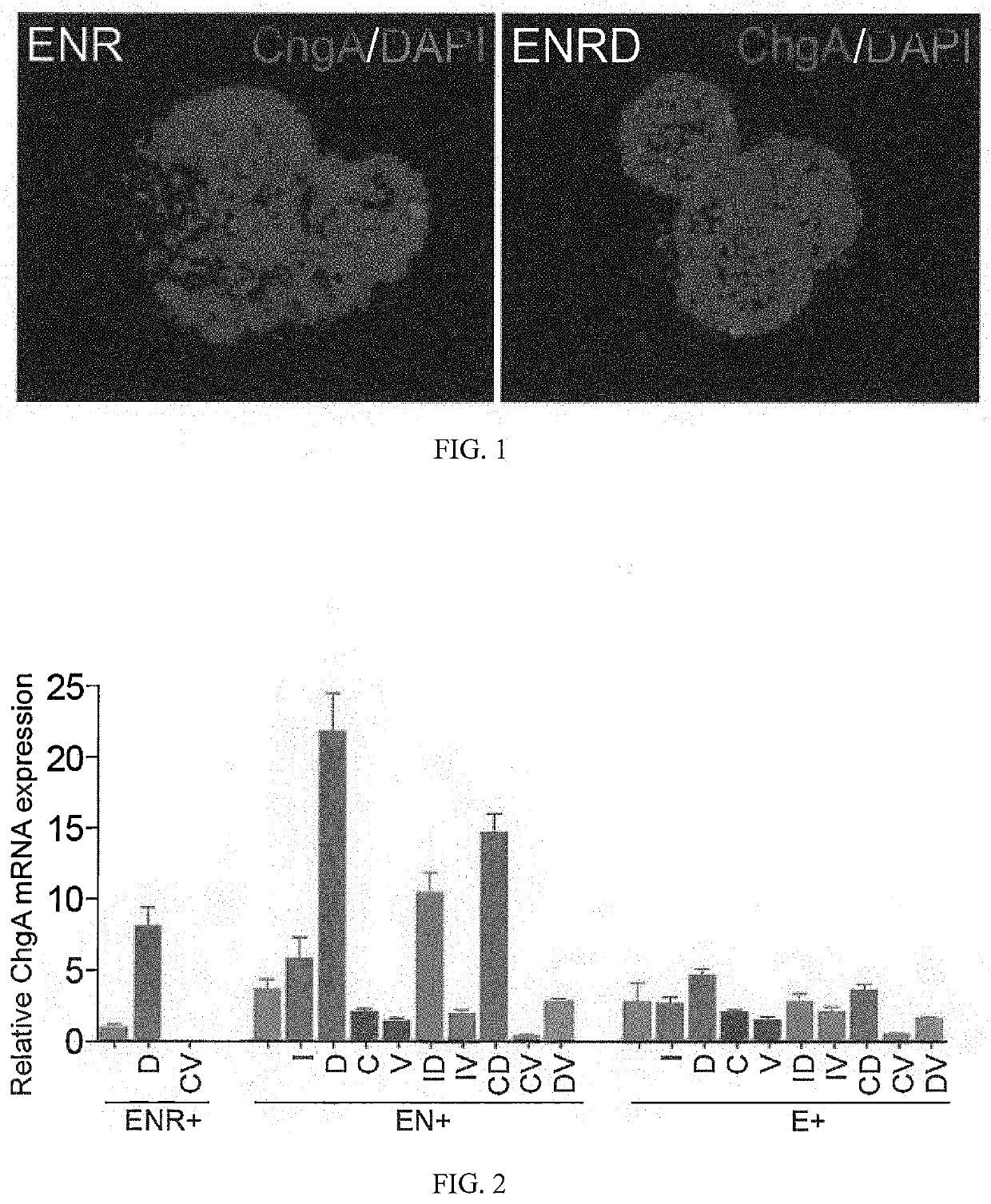Production of differentiated enteroendocrine cells and insulin producing cells
a technology which is applied in the field of differentiation of enteroendocrine cells and insulin producing cells, can solve the problems of difficult to study the function and regulation of eecs in situ, hinder the study of enteroendocrine cells, and inability to direct in vitro study of eecs, etc., to achieve the effect of increasing the insulin expression of a population of mammalian cells, increasing the insulin expression, and promoting cell differentiation
- Summary
- Abstract
- Description
- Claims
- Application Information
AI Technical Summary
Benefits of technology
Problems solved by technology
Method used
Image
Examples
example 1
[0201]Mice
[0202]Lgr5-EGFP-IRES-CreERT2, B6.129 mice and Insulin-GFP (Ins-GFP, B6.Cg-Tg (Ins1-EGFP)1Hara / J) mice were obtained from Jackson Labs, and 6- to 12-week-old mice were used for crypt cell isolation. Animal experimental procedures were approved by the Committee on Animal Care (CAC) at MIT.
example 2
[0203]Crypt Isolation
[0204]Crypts were isolated as previously described (Yin et al., Nature Methods, 2014). The proximal half of the small intestine was harvested, opened longitudinally and washed with cold PBS to remove luminal content. The tissue was then cut into 2 mm to 4 mm pieces with scissors and further washed 5-10 times with cold PBS by pipetting up and down using a 10 mL pipette. Tissue fragments were incubated with 2 mM EDTA in PBS for 30 min on ice. After removal of EDTA, tissue fragments were washed with PBS to release crypts. The crypts were then collected, washed, and used for cell culture. Released crypts were collected and passed through a 70 μm cell strainer. Isolated crypts were embedded in Matrigel and plated at the center of wells in a 24-well plate.
example 3
[0205]Cell Culture
[0206]Isolated crypts or single cells were cultured as previously described. 200-300 crypts were mixed with 40 μl of Matrigel and plated at the center of wells in a 24-well plate. Following polymerization of Matrigel, 500 μl of crypt culture media (Advanced DMEM / F12 with N2, B27, Glutamax, HEPES, and N-acetylcysteine) containing growth factors (EGF, Noggin, R-Spondin 1) and small molecules (CHIR99021 and VPA) were provided. For cell differentiation experiments, the cell culture media was changed to media containing growth factors and small molecules as listed in Table 2 following the differentiation protocol as described below. Media were changed every 1-2 days depending on the differentiation condition used.
[0207]
TABLE 2Small molecules and growth factors used in studyAbbre-NameviationConcentrationCompanyCat #EGFE50ng / mlThermoFisherPHG0311NogginN100ng / mlPeprotech250-38R-Spondin 1R500ng / mlPeprotech120-38CHIR99021C4uMSelleckchemS1263VPAV1.5mMSigmaP4543(Vaproic AcidSo...
PUM
| Property | Measurement | Unit |
|---|---|---|
| time | aaaaa | aaaaa |
| time | aaaaa | aaaaa |
| molecular weight | aaaaa | aaaaa |
Abstract
Description
Claims
Application Information
 Login to View More
Login to View More - R&D
- Intellectual Property
- Life Sciences
- Materials
- Tech Scout
- Unparalleled Data Quality
- Higher Quality Content
- 60% Fewer Hallucinations
Browse by: Latest US Patents, China's latest patents, Technical Efficacy Thesaurus, Application Domain, Technology Topic, Popular Technical Reports.
© 2025 PatSnap. All rights reserved.Legal|Privacy policy|Modern Slavery Act Transparency Statement|Sitemap|About US| Contact US: help@patsnap.com



